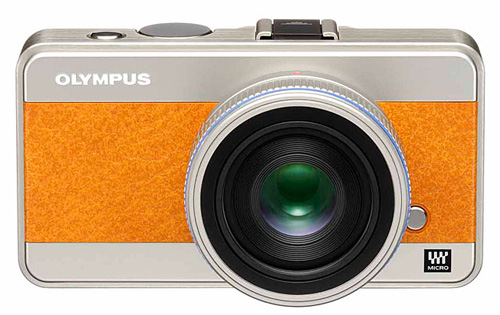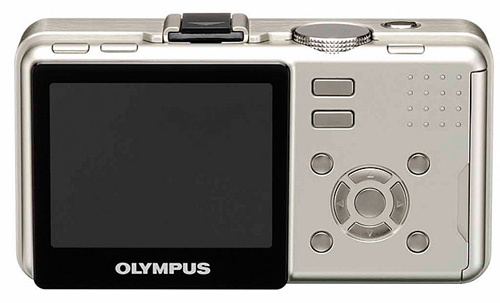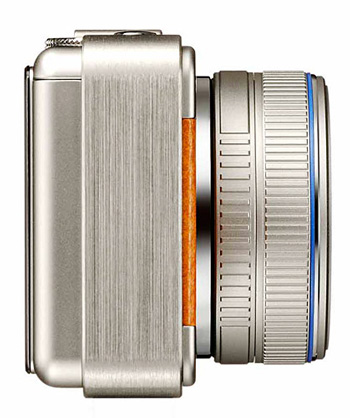Photokina 2008: Full-Frame and Megapixels Rule
by Wesley Fink on September 26, 2008 2:00 AM EST- Posted in
- Digital Camera
Olympus
Olympus created a great deal of interest showing prototypes, but they didn't even have real model numbers to go with the new midrange Olympus DSLR or the prototype of the new interchangeable lens compact based on Micro Four Thirds.
Olympus fans will be pleased to know that Olympus is planning to introduce a new midrange model in the first quarter of next year. The new unnamed model will fall between the current E-520 and the flagship E-3. Finally, Olympus will bring the superb 11 cross-point sensor used in the zippy E-3 to a consumer model with the new camera. The unanswered question is whether the new camera will stick with a 10MP sensor, which is now the lowest resolution among DSLR APS-C cameras, or whether they will move to the new Panasonic Four Thirds 12.1MP sensor used in their new G1.
Olympus was also showing prototypes of their first interchangeable lens compact camera, or point and shoot, based on the Panasonic Olympus Micro Four Thirds standard. You can out more about the new Micro Four Thirds standard in our analysis of the Panasonic G1 launch.



The new Four Thirds Olympus point-and-shoot finally accomplishes what many have been clamoring for in the P&S market - namely a large sensor in a point-and-shoot size body. The prototype has interchangeable Micro Four Thirds lenses and can fit today's Four Thirds lenses by using an adapter. You will also likely see fixed lens Micro Four Thirds cameras at a lower price sometime in the future.
The two new Olympus cameras are intriguing, but they are likely at least six months away. Olympus should have final models ready for PMA in February/March of 2009. Unfortunately, the Olympus press release really did not provide answers to the most pressing questions:
Olympus Developing New E-System Four Thirds System-Compliant Digital SLR Camera
COLOGNE, GERMANY, September 22, 2008 - Olympus today announces that it is developing a new interchangeable-lens digital SLR (single lens reflex) within the Olympus E-System lineup. This new Four Thirds-compliant camera reinforces the company's commitment to the standard.
Positioned as a midrange model, this new digital SLR camera is intended for anyone who wants to express their creativity through photography, whether they are just starting out or are a professional with years of experience behind them. Introduction of the new camera is expected in the first quarter of 2009.
A prototype of the camera will be displayed at Photokina 2008, the world's largest trade fair for the photographic and imaging industries held September 23-28 at the Cologne Trade Fair in Cologne, Germany.
At the last Photokina (September 2006), Olympus declared that the second chapter in the story of the Olympus E-System would begin in 2007. One of the highlights of this chapter was the incorporation of "Full-Time Live View" function as a standard function for the first time in the industry, adding to the excitement already generated by other distinctive features of the E-System such as the "100 percent Digital-Dedicated Design" and "Dust Reduction System." Currently, the E-System lineup includes popular models such as the E-420 and E-520, as well as the flagship E-3. All of these cameras provide digital SLR users with the high-quality images, superior reliability and exceptional portability they need.
The prototype model displayed at Photokina is being developed as an advanced amateur model that will be positioned between the E-520 and E-3. In terms of quality and performance, however, there is nothing midrange about this model. It will inherit all the outstanding features of the E-3 such as the high-speed autofocus system using an 11-point full twin-cross sensor and the built-in image stabilization mechanism with a correction effect of up to 5 EV steps. Other highlights will include a new and updated feature to replace the current splash and dustproof function of the E-3.
With the introduction of this new camera, Olympus will expand its line of Four Thirds System-compliant digital SLR cameras, providing a wider range of choices to a wider range of users from serious amateurs to professionals.
Olympus Micro Four Thirds System-Compliant Digital Camera Under Development

Cologne, Germany, September 22, 2008 - Olympus today announces that it has begun development of an interchangeable lens type digital camera based on the "Micro Four Thirds System".
Development of the camera will bring dramatic reductions in size and weight to the Olympus E-System, and will comply with the new Micro Four Thirds System standard jointly announced with Matsushita Industrial Co., Ltd. (Panasonic) on August 5. A concept mock-up of the camera will be exhibited September 23-28 at "Photokina 2008," the world's largest trade fair for the photographic and imaging industries held September 23-28 at the Cologne Trade Fair in Cologne, Germany.
The global market for interchangeable lens type digital cameras is growing steadily, but still only accounts for approximately 7 percent of the total digital camera market. Considering the much larger share held by interchangeable lens type digital cameras when film was the dominant imaging medium, it seems that there is still ample room for sales growth in this category. Market surveys, however, indicate that more than a few customers choose compact models because they find digital SLR cameras to be "big, heavy, and difficult to operate."
The Micro Four Thirds System standard was established to meet this need by enabling the development of radically more compact and lightweight interchangeable lens type digital camera systems. The camera currently under development will be the first Olympus camera to comply with the Micro Four Thirds System standard, and interchangeable lenses that comply with the standard are also moving ahead. In addition, users will be able to mount existing Four Thirds System wide-angle, telephoto, and macro lenses on Micro Four Thirds System bodies via an adapter. Product name, launch date and retail price of an interchangeable lens type digital camera based on the "Micro Four Thirds System" are not determined.
Olympus Imaging is also committed to the Four Thirds System, and will continue to expand its lineup of digital SLR cameras to satisfy a broad spectrum of customer needs. This includes the professional photographer, aspiring artist, hobbyist, and everyday consumer.
Outline of the Micro Four Thirds standard The Micro Four Thirds standard was designed and developed to maximize the performance potential of digital imaging technology, and to extend the benefits of the Four Thirds System standard for digital camera systems.
When compared to the Four Thirds System standard, the primary distinguishing features of the Micro Four Thirds standard are:
- Approximately 50 percent shorter flangeback distance (mount-to-sensor distance)
- Lens mount outer diameter approximately 6mm smaller
- Electrical contacts in mount increased from 9 to 11
The Micro Four Thirds System enables users to capture the same high-quality images of the Four Thirds System's image sensor in a much more compact body. It also takes advantage of significantly more compact lenses, particularly in the wide-angle and high-power zoom range. The Four Thirds System offers the benefits of compact, lightweight performance, and the new Micro Four Thirds System takes this even further to enable development of ultra-compact interchangeable lens type digital camera systems unlike anything seen before. The new Micro Four Thirds System also incorporates a greater number of lens-mount electrical contacts for the support of new features and expanded system functionality in the future.










16 Comments
View All Comments
plonk420 - Saturday, September 27, 2008 - link
one person i know says that this is a breakthru for indy film producers. another person in film doesn't believe that it's coming from a digiSLR...http://vincentlaforet.com/">http://vincentlaforet.com/
a short film produced WITHOUT POST PRODUCTION (save for resizing) with the 5D Mark II as source. impromptu petition has even been setup to try to convince Canon to bequeath it with 24p in a firmware update...
yyrkoon - Saturday, September 27, 2008 - link
Being the leader in image manipulation, I am surprised that Adobe gave no details as to what CS4 is capable of ? This is an assumption on my behalf because I am sure you guys at Anandtech.com *would* report the nitty-gritty if it were made available . . . right ?It is rumored that CS4 will take advantage of CUDA for parallel processing of images. This could be a HUGE boon for image retouchers, and judging from the current CUDA enabled scripting filter examples on Adobes site, I would view this as the next logical step for them.
Wesley Fink - Saturday, September 27, 2008 - link
The info provided by Adobe was short on specifics and big on sweeping generalities in the Press release. Adobe does claim more support of current hardware and is said to fully support quad core processing. That should interest our readers. CS4 also claims to better support today's graphics cards (GPU) for smoother pan and zoom functions though they don't specify which GPU hardware they are talking about.To be blunt most PS users are forced to upgrade because Adobe makes new versions of its very popular Camera RAW plug-in incompatible with older PS versions. That means when you finally get your newer camera you are forced to upgrade PS if you want to process RAW files in Photoshop.
We believed our readers would want to know a new version of Photoshop is coming, and they could find out more it they were interested. You can see the Press Release for yourself at http://www.adobe.com/aboutadobe/pressroom/pressrel...">http://www.adobe.com/aboutadobe/pressro...srelease... We decided not to repeat it. We will know more when Photoshop CS4 and PS CS4 Extended ship next month.
yyrkoon - Saturday, September 27, 2008 - link
Yeah, thats exactly what I did: read adobes support pages, and the list is quite extensive. Albeit not as extensive as I hoped.One thing that Adobe can not do quite right is standardize their UI, which they have changed AGAIN, and honestly it is annoying. They *claim* it will improve the user experience, and help speed things up, but that yet remains to be seen.
melgross - Friday, September 26, 2008 - link
There's an error in the first chart. The Nikon etc. numbers should read 15.7 x 23.5.This also shows why the 4/3 format has such a problem. If Olympus/Panasonic want to make a 15 MP sensor, the pixel density will jump to 6.2. That's way above where the other cameras will be. The 50D, with 15 MP is at 4.5. This will be a disadvantage in S/N. With less pixels, this hasn't been as much of a problem (though Panasonic has always has noise problems), but as site size continues to diminish, they will find it more difficult to make up for it.
Wesley Fink - Friday, September 26, 2008 - link
Dimension is corrected. The area was correct, but the decimal number for one dimension got dropped in editing.melgross - Friday, September 26, 2008 - link
Olympus doesn't use the faster, and often more accurate, phase detection for auto focus?Or is it that the compatibility will only extend to the older method of contrast detection?
If so, and there's no phase detection, that's a negative.
strikeback03 - Monday, September 29, 2008 - link
They do use phase detect in their SLRs, along with some having contrast detect capability. The micro-4/3 cameras, as they have no mirror or other means of redirecting light, cannot use phase detect AF.And I also wonder why anything in the lens has something to do with whether contrast detect AF works or not.
Johnmcl7 - Friday, September 26, 2008 - link
"The prototype has interchangeable Micro Four Thirds lenses and can fit today's Four Thirds lenses with full functionality by using an adapter"As far as I'm aware the G1 does not have full compatibility with 4/3 lenses, there's no AF unless the lens supports contrast detect AF which is expected to be the same for the Olympus micro 4/3. The press release is vague on the point as it simply says you can mnount the lenses.
John
Wesley Fink - Friday, September 26, 2008 - link
You are certainly correct that the Press release is less than crystal clear on this point. Based on the info you provide I have slightly changed the description you quote to remove "with full functionality".We are also dealing with a prototype 6 months from introduction and we can only speculate on the shipping product. If your speculation is correct then four current 4/3 lenses support contrast detect. They are the 14-42mm, 40-150mm, 25mm f2.8, and the latest Panasonic/Leica 14-50mm.
Olympus was able to add contrast-detect compatibility to these lenses with a firmware upgrade. We are left to wonder whether that may be possible with other current 4/3 lenses. We will know with the shipping Olympus Micro 4/3 compact.